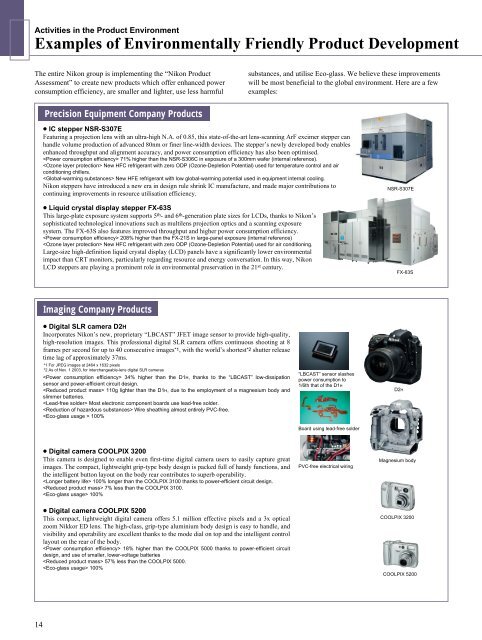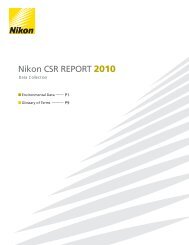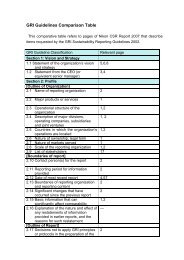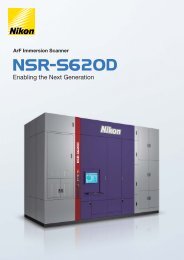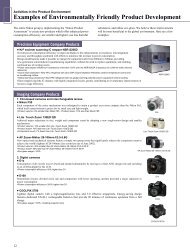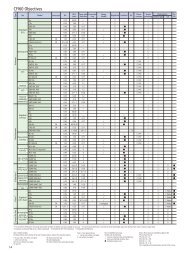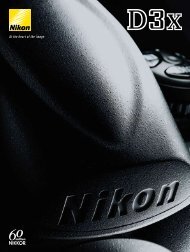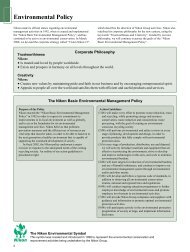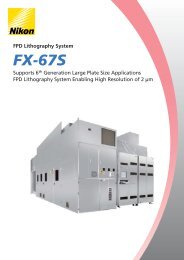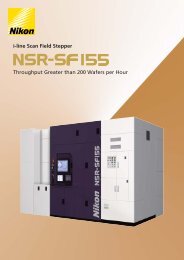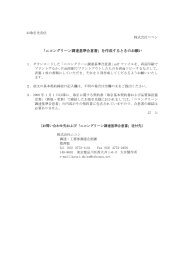Examples of Environmentally Friendly Product Development - Nikon
Examples of Environmentally Friendly Product Development - Nikon
Examples of Environmentally Friendly Product Development - Nikon
- No tags were found...
You also want an ePaper? Increase the reach of your titles
YUMPU automatically turns print PDFs into web optimized ePapers that Google loves.
Activities in the <strong>Product</strong> Environment<strong>Examples</strong> <strong>of</strong> <strong>Environmentally</strong> <strong>Friendly</strong> <strong>Product</strong> <strong>Development</strong>The entire <strong>Nikon</strong> group is implementing the “<strong>Nikon</strong> <strong>Product</strong>Assessment” to create new products which <strong>of</strong>fer enhanced powerconsumption efficiency, are smaller and lighter, use less harmfulsubstances, and utilise Eco-glass. We believe these improvementswill be most beneficial to the global environment. Here are a fewexamples:Precision Equipment Company <strong>Product</strong>s• IC stepper NSR-S307EFeaturing a projection lens with an ultra-high N.A. <strong>of</strong> 0.85, this state-<strong>of</strong>-the-art lens-scanning ArF excimer stepper canhandle volume production <strong>of</strong> advanced 80nm or finer line-width devices. The stepper’s newly developed body enablesenhanced throughput and alignment accuracy, and power consumption efficiency has also been optimised. 71% higher than the NSR-S306C in exposure <strong>of</strong> a 300mm wafer (internal reference). New HFC refrigerant with zero ODP (Ozone-Depletion Potential) used for temperature control and airconditioning chillers. New HFE refrigerant with low global-warming potential used in equipment internal cooling.<strong>Nikon</strong> steppers have introduced a new era in design rule shrink IC manufacture, and made major contributions tocontinuing improvements in resource utilisation efficiency.• Liquid crystal display stepper FX-63SThis large-plate exposure system supports 5 th - and 6 th -generation plate sizes for LCDs, thanks to <strong>Nikon</strong>’ssophisticated technological innovations such as multilens projection optics and a scanning exposuresystem. The FX-63S also features improved throughput and higher power consumption efficiency. 208% higher than the FX-21S in large-panel exposure (internal reference) New HFC refrigerant with zero ODP (Ozone-Depletion Potential) used for air conditioning.Large-size high-definition liquid crystal display (LCD) panels have a significantly lower environmentalimpact than CRT monitors, particularly regarding resource and energy conversation. In this way, <strong>Nikon</strong>LCD steppers are playing a prominent role in environmental preservation in the 21 st century.NSR-S307EFX-63SImaging Company <strong>Product</strong>s• Digital SLR camera D2HIncorporates <strong>Nikon</strong>’s new, proprietary “LBCAST” JFET image sensor to provide high-quality,high-resolution images. This pr<strong>of</strong>essional digital SLR camera <strong>of</strong>fers continuous shooting at 8frames per second for up to 40 consecutive images*1, with the world’s shortest*2 shutter releasetime lag <strong>of</strong> approximately 37ms.*1 For JPEG images at 2464 x 1632 pixels*2 As <strong>of</strong> Nov. 1 2003, for interchangeable-lens digital SLR cameras 34% higher than the D1H, thanks to the “LBCAST” low-dissipationsensor and power-efficient circuit design. 110g lighter than the D1H, due to the employment <strong>of</strong> a magnesium body andslimmer batteries. Most electronic component boards use lead-free solder. Wire sheathing almost entirely PVC-free. 100%“LBCAST” sensor slashespower consumption to1/6th that <strong>of</strong> the D1HD2HBoard using lead-free solder• Digital camera COOLPIX 3200This camera is designed to enable even first-time digital camera users to easily capture greatimages. The compact, lightweight grip-type body design is packed full <strong>of</strong> handy functions, andthe intelligent button layout on the body rear contributes to superb operability. 100% longer than the COOLPIX 3100 thanks to power-efficient circuit design. 7% less than the COOLPIX 3100. 100%PVC-free electrical wiringMagnesium body• Digital camera COOLPIX 5200This compact, lightweight digital camera <strong>of</strong>fers 5.1 million effective pixels and a 3x opticalzoom Nikkor ED lens. The high-class, grip-type aluminium body design is easy to handle, andvisibility and operability are excellent thanks to the mode dial on top and the intelligent controllayout on the rear <strong>of</strong> the body. 18% higher than the COOLPIX 5000 thanks to power-efficient circuitdesign, and use <strong>of</strong> smaller, lower-voltage batteries 57% less than the COOLPIX 5000. 100%COOLPIX 3200COOLPIX 520014
Targets[Energy consumption efficiency]• Improvement in operational energy consumption efficiency <strong>of</strong> 10% or greater for newly released products, compared with figures for fiscal 2001.[Ozone layer-damaging substances]• Reduction <strong>of</strong> IC and LCD steppers using HCFC to fewer than 15% <strong>of</strong> all products.• Interchangeable lens AF-S DX Zoom-Nikkor ED 18-70mm f3.5-4.5G IFThis standard zoom lens was developed specifically for use with <strong>Nikon</strong> digital SLR cameras. Theoptical system and mechanisms are super light, and resolving power has never been higher. The SilentWave Motor (SWM) delivers fast, quiet auto-focussing drive performance.Since March <strong>of</strong> 2004, this lens has been packaged with the D70, the winner <strong>of</strong> the TIPA* BestConsumer Digital SLR Camera in Europe 2004 award. The lens is also sold separately. 14% less than the AF Zoom-Nikkor 28-105mm f3.5-4.5D IF. 100%AF-S DX Zoom-Nikkor 18-70mm F3.5-4.5G IF-ED• Film scanner SUPER COOLSCAN 5000 ED, COOLSCAN V EDThe SUPER COOLSCAN 5000 ED is a high-resolution, 4000-dpi film scanner employing a ScannerNikkor ED lens, and features unsurpassed resolving power, delivering scans as fast and crisp as anyscanner in its class. The COOLSCAN V ED, an affordable, user-friendly film scanner <strong>of</strong>fering finequality and enhanced speed, won the TIPA* Best Film Scanner in Europe 2004 award.* TIPA (Technical Image Press Association) is composed <strong>of</strong> editors from major European camera and imaging specialty magazines, and selects the bestimaging products in a number <strong>of</strong> categories every year. SUPER COOLSCAN 5000 ED: 50% higher than the SUPER COOLSCAN 4000 EDthanks to reduced scan times; COOLSCAN V ED: 13% higher than the COOLSCAN IV ED. Certified under International Energy Star Programme. 100%SUPER COOLSCAN 5000 EDCOOLSCAN V EDInstruments Company <strong>Product</strong>s• Biological microscope for medical and clinical use ECLIPSE 55iThe ECLIPSE 55i employs white LED illumination as its light source — this enables lower-temperature operationthan with conventional halogen lamps, and a drastic reduction in power consumption, from 48W to a mere 6W. Themicroscope can also be operated using lithium-ion batteries (optional). As with prior models, Köhler illumination isused for the aperture. The life <strong>of</strong> the light source has also been significantly extended, minimising waste and makingthe product more environmentally friendly. 800% higher than the ECLIPSE E400. About 80 times longer than the ECLIPSE E400. 100%• Overlay measurement system NRM-3100With low aberration, high-S/N imaging system and high rigidity for more accurate stage positioning, this high-speed,high-resolution overlay measurement system accommodates 300mm wafers at throughputs <strong>of</strong> up to 150 wafers perhour in 90nm lithography process. User-friendly s<strong>of</strong>tware minimises the time required to create recipes, contributingto superb operability. While throughput and power consumption have been maintained from the prior model, thesupported wafer size has been improved from 200 to 300mm, and measurement resolution from 130 to 90nm. As aresult, the new system can process 4.7 times more ICs per unit <strong>of</strong> power consumed. 370% higher than the NRM-1000A. No PBDE or PBB used as flame retardant in resin materials or wire sheathing. 89%ECLIPSE 55iNRM-310015
Targets[Energy consumption efficiency]• Improvement in operational energy consumption efficiency <strong>of</strong> 10% or greater for newly released products, compared with figures for fiscal 2001.[Ozone layer-damaging substances]• Reduction <strong>of</strong> IC and LCD steppers using HCFC to fewer than 15% <strong>of</strong> all products.<strong>Nikon</strong> Group <strong>Product</strong>s• Portable laser rangefinder LASER 800SThe LASER 800, which has already earned high marks as a laser rangefinder for outdoor activities and sports suchas golf, features a sophisticated fusion <strong>of</strong> telescope and electronics. Now it has been completely revamped forimproved performance, and enhanced portability and environmental friendliness. Battery life has been significantlyextended by reducing power consumption in standby and operation, and reducing measurement time. 250% higher than the LASER 800. 22% less mass and 40% less volume than the LASER 800. Nitrogen-filled waterpro<strong>of</strong>ing prevents equipment malfunction caused by moisture. Lead-free solder used on all circuit boards. No PVC used in wire sheathing, body, case or strap. 100%Smaller, lighter components,lead-free board and• Binoculars 8x42HG L D CF/10x42HG L D CFPVC-free wiring<strong>Nikon</strong>’s High-Grade binoculars deliver unrivalled performance. The body is tough yetlightweight, made from magnesium alloy and other low specific-gravity materials, withcarefully crafted contours. The industry’s first non-PVC elastomer was used in the body,eyepiece caps, case and strap. The lenses are 100% Eco-glass. 8x42HG L D CF: 18.9% less than the old HG Series; 10x42HG L D CF: 19.4% less. No PVC used in internal or external components, case or strap. 100%8x42HG L D CFLASER 800SPVC-free case, strap10x42HG L D CFFuture ActivitiesWe have established a rigorous system for environment-orienteddesign activities with continual enhancement. We are applying thissystem to greater energy efficiency improvement, full-scale usage<strong>of</strong> lead-free solders and Eco-glass, and the reduction <strong>of</strong> harmfulheavy metals and polyvinyl chloride. We are confident that ouractivities will result in an entirely new level <strong>of</strong> environmentalfriendliness.<strong>Nikon</strong> EnvironmentalAction Plan(product environment)<strong>Product</strong> environmentalaspect evaluation(assessing currentsituation)See pages 10,11Environmental targets foreach product, programme toachieve targets<strong>Development</strong>and design<strong>Nikon</strong> <strong>Product</strong>AssessmentDesign review,productcommercialisationmeeting16
Activities in the <strong>Product</strong> EnvironmentContainers and PackagingTargets[Plastic containers and packaging]• Reduction <strong>of</strong> at least 30% compared with figures from fiscal 2001.<strong>Nikon</strong> defined its “Environmental Policy Regarding PackagingMaterials” in May 1998, and reviewed it in June 2000. This policyhas seven main points:1. Elimination <strong>of</strong> harmful substances. 2. Reduction in volume andcontent. 3. Recyclability. 4. Safety and ease <strong>of</strong> separation <strong>of</strong>materials. 5. Use <strong>of</strong> recycled resources. 6. Reusability. 7. Markingregarding packaging materials and handling precautions.The activities implemented based on this policy are asdescribed in the following chart:Non-vinylchloride filmTheme Policy Contents ApplicationPlant-derivedfiller materialsCushioning filmReinforcedcardboard boxesSingle-materialpresentation cases1. Elimination <strong>of</strong> harmfulsubstances2. Reduction in volume andcontent2. Reduction in volume andcontent2. Reduction in volume andcontent3. Recyclability5. Use <strong>of</strong> recycled resources4. Safety and ease <strong>of</strong>separation <strong>of</strong> materialsSwitch from use <strong>of</strong> vinyl chloride material, which is considered a majorsource <strong>of</strong> dioxin, to non-vinyl chloride materials such as polypropylene.Plant-derived filler materials are made from bean and wheat husks. Theyare significantly safer and more environmentally friendly filler materialsthan those derived from crude oil. We also use biodegradable resins inpackaging containing filler materials.Support with elastic film enables significantly reduced consumption <strong>of</strong>cushioning material.Adoption <strong>of</strong> reinforced three-layer cardboard boxes has enabled asignificant reduction in weight and volume <strong>of</strong> packaging in comparisonwith old-style wooden boxes.Use <strong>of</strong> film in presentation cases has been eliminated. Cases are nowmade from paper only, for ease <strong>of</strong> breakdown and decomposition.Wrapping materialsfor equipment suchas steppersMicroscopesCamerasStepper body(for shipping tocertain destinations)AccessoriesCushioning filmReinforced cardboard boxesAssembly-typepackagingSteel palletPulp mouldingDedicated transportcontainersPolyethylenebags4. Safety and ease <strong>of</strong>separation <strong>of</strong> materials4. Safety and ease <strong>of</strong>separation <strong>of</strong> materials6. Reusability5. Use <strong>of</strong> recycledresources6. Reusability7. Marking regardingpackaging materials andhandling precautionsSo far, we have achieved the following in our challenge to meet targets:In fiscal 2003, use <strong>of</strong> plastic containers and packaging forconsumer products increased to 159% in weight against fiscal2001 levels due to the dramatic growth <strong>of</strong> the digital camerabusiness. Despite our best efforts to reduce the use <strong>of</strong> plastic, theThe filler material and the cardboard are assembled manually for ease <strong>of</strong>separation later. Old-style packaging involved a fusing <strong>of</strong> different materials(cardboard and a crude-oil derived filler material).Smoke sterilisation process used with wooden pallets is no longer necessary.This also contributes to conservation <strong>of</strong> the forests.A paper filler material consisting <strong>of</strong> 55% recycled paper. This material isgradually being introduced as an alternative to crude oil derivatives.Dedicated containers are used for shipment to certain corporations.All packaging material is marked to facilitate separation. All bags, otherthan those <strong>of</strong> extremely small size, are marked with a warning <strong>of</strong>suffocation risk to infants.• •MicroscopesStepperCameras, interchangeablelenses, microscopesMicroscopesSteel palletPulp mouldingfigure rose to 240% in weight in fiscal 2004.Through the use <strong>of</strong> single-material presentation cases andassembly-type packaging, as well as other methods, from fiscal2002 through 2003 we achieved our target <strong>of</strong> eliminating the use<strong>of</strong> non-separable multi-material for new packaging in fiscal 2004.Activities in the <strong>Product</strong> Environment<strong>Examples</strong> <strong>of</strong> Implementation in Sales and Distribution<strong>Nikon</strong> is working tirelessly to reduce the total and long-termenvironmental impact <strong>of</strong> its products and services. Since <strong>Nikon</strong>supplies products worldwide, we must also pay strict attention tosales and distribution activities. The following are some examples<strong>of</strong> our reuse and recycling efforts in these areas:1. Sales <strong>of</strong> used steppers for reuse<strong>Nikon</strong> Tec Corporation has been collecting used steppers discardedby customers, and reconditioning and reselling them for new users,with the appropriate services supplied.This is an example <strong>of</strong> <strong>Nikon</strong>’s willingness and capability toreuse its own products. Fiscal 2004 saw 46 significant achievements(compared to 12 in fiscal 2003), both domestically and abroad,contributing to a dramatic expansion <strong>of</strong> our business. Themanufacturing department, which lends its efforts to thereproduction and control process, shortens the work period andsupports business expansion by promoting the improvement <strong>of</strong>industrial tools and machines, standardising <strong>of</strong> the workflow andimproving its efficiency and putting in place a framework fortechnical troubleshooting.<strong>Nikon</strong> is conducting in-depth research on the needs <strong>of</strong> thesemiconductor industry, in order to help companies in the field toexpand their businesses. This is another area in which ourdedication to environmental preservation, pr<strong>of</strong>itability and customerservice shines through.2. Recycling <strong>of</strong> packaging materials and batteries in Japan(1) Packaging materials<strong>Nikon</strong> have contracted the services <strong>of</strong> JCPRA (Japan Containersand Packaging Recycling Association) to collect and recyclepackaging materials used during the sale <strong>of</strong> <strong>Nikon</strong> products.(2) Batteries<strong>Nikon</strong> and many other companies have engaged in cooperativeefforts with JBRC (Japan Battery Recycling Center) to collect andrecycle rechargeable batteries for digital cameras and other productsdiscarded by consumers.3. Recycling <strong>of</strong> packaging materials and batteries in Europe(1) Packaging materialsOur overseas subsidiaries have contracted the services <strong>of</strong> DSD(Duales System Deutschland) to collect and recycle packagingmaterials used during the sale <strong>of</strong> <strong>Nikon</strong> products.(2) BatteriesOur overseas subsidiaries have contracted the services <strong>of</strong> GRS (StiftungGemeinsames Rücknahmesystem Batterien) to collect and recyclebatteries for cameras and other products discarded by consumers.17


